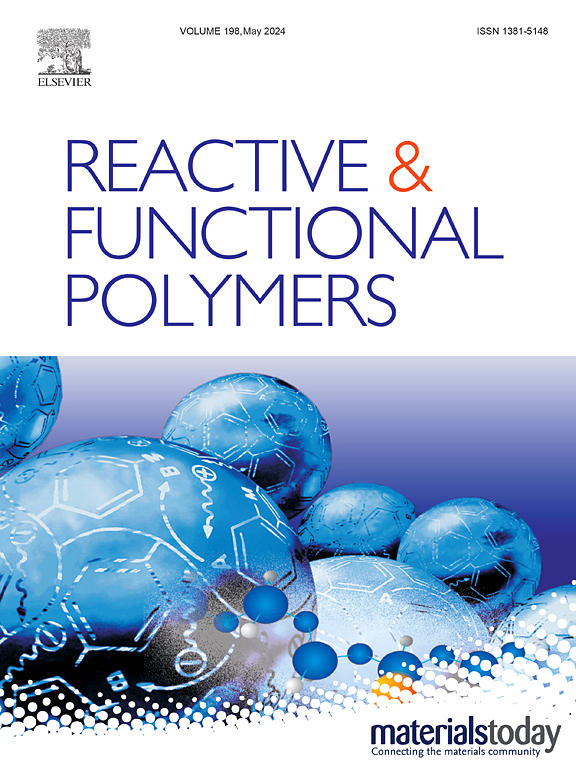戊二醛或庚尼平交联壳聚糖膜的介电性能
IF 4.5
3区 工程技术
Q1 CHEMISTRY, APPLIED
引用次数: 0
摘要
本文研究了戊二醛(GA)和生物基替代吉尼平(GP)共价交联对壳聚糖膜介电和导电性能的影响。为了进行质子化,将溶剂铸膜浸入1.0 M硫酸溶液(S)中。使用傅里叶变换红外光谱(FTIR)、吸水研究、差示扫描量热法(DSC)和介电热分析(DETA)来评估所产生的性能变化。与戊二醛交联膜相比,格尼平交联膜表现出更高的吸水性,这是由于交联效果较差,聚合物链之间的自由体积较大。浸在硫酸溶液中的膜由于短离子桥形成的更致密的结构而表现出吸水减少和膨胀。所有壳聚糖基材料的介电光谱都具有相同的弛豫机制(β-、β湿-、α-弛豫和MWS极化)。共价交联和硫酸浸泡增加了β-松弛的活化能,这是由于形成的强键限制了糖苷键的迁移。共价键限制了壳聚糖骨架的节段动力学,导致相关α-弛豫的Vogel温度升高,特别是与戊二醛的弛豫。硫酸溶液处理后,β湿松弛温度降低,这是由于带电荷的硫酸盐基团掺入导致结合水潴留增加。本文章由计算机程序翻译,如有差异,请以英文原文为准。

Dielectric properties of chitosan membranes cross-linked with glutaraldehyde or genipin
This study investigates the impact of covalent cross-linking using glutaraldehyde (GA) and the biobased alternative genipin (GP) on the dielectric and conductive properties of chitosan membranes. For protonation, the solvent-casted membranes were immersed in a 1.0 M sulfuric acid solution (S). The resulting property changes were assessed using Fourier-Transform Infrared (FTIR) spectroscopy, water uptake studies, Differential Scanning Calorimetry (DSC), and Dielectric Thermal Analysis (DETA). The genipin-cross-linked membrane demonstrated higher water uptake than the glutaraldehyde-cross-linked one, attributed to less effective cross-linking and greater free volume between polymer chains. The membranes immersed in the sulfuric acid solution exhibited reduced water uptake and swelling due to a denser structure formed by short ionic bridges. All the chitosan-based materials showed dielectric spectra containing the same relaxation mechanisms (β-, βwet-, α-relaxation, and MWS polarisation). Covalent cross-linking and sulfuric acid immersion increased the activation energy of the β-relaxation, due to the formation of strong bonds that limit the mobility of glycosidic linkages. The covalent bonds restrict the segmental dynamics of the chitosan backbone, leading to an increase in the Vogel temperature of the associated α-relaxation, particularly with glutaraldehyde. The βwet-relaxation temperature decreased following sulfuric acid solution treatment, due to greater retention of bound water resulting from the incorporation of charged sulfate groups.
求助全文
通过发布文献求助,成功后即可免费获取论文全文。
去求助
来源期刊

Reactive & Functional Polymers
工程技术-高分子科学
CiteScore
8.90
自引率
5.90%
发文量
259
审稿时长
27 days
期刊介绍:
Reactive & Functional Polymers provides a forum to disseminate original ideas, concepts and developments in the science and technology of polymers with functional groups, which impart specific chemical reactivity or physical, chemical, structural, biological, and pharmacological functionality. The scope covers organic polymers, acting for instance as reagents, catalysts, templates, ion-exchangers, selective sorbents, chelating or antimicrobial agents, drug carriers, sensors, membranes, and hydrogels. This also includes reactive cross-linkable prepolymers and high-performance thermosetting polymers, natural or degradable polymers, conducting polymers, and porous polymers.
Original research articles must contain thorough molecular and material characterization data on synthesis of the above polymers in combination with their applications. Applications include but are not limited to catalysis, water or effluent treatment, separations and recovery, electronics and information storage, energy conversion, encapsulation, or adhesion.
 求助内容:
求助内容: 应助结果提醒方式:
应助结果提醒方式:


